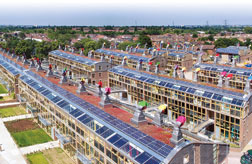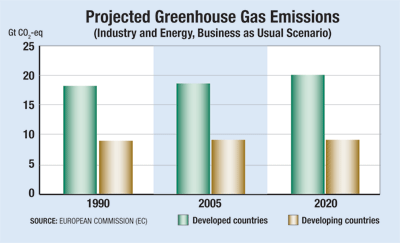 ZEDfactory Ltd U.K.'s BedZED is carbon-neutral pioneer.
|
Global warming, already a hot topic, will likely heat up more following this month’s assessment by the United Nations Intergovernmental Panel on Climate Change. The Feb. 2 report cites, with more than 90% certainty, human use of fossil fuels as the main cause of climate change.
IPCC’s findings, based largely on peer-reviewed reports by hundreds of scientists around the globe, immediately prompted calls for high-level talks to extend the historic greenhouse-gas-emission-cutting Kyoto Protocol as it nears its second anniversary on Feb. 16.
IPCC’s periodic predictions are the scientific basis for the Kyoto Protocol. The protocol binds the industrialized world to reduce emissions, largely of carbon dioxide, into the air by an average of at least 5% by 2012.
|
The protocol, with over 100 signatories, is “an extraordinary achievement,” said British Prime Minister Tony Blair in his closing speech at last month’s World Economic Forum, in Switzerland. Yet “even if implemented...it would only stabilize emissions. We need them cut,” probably by 60% by 2050, he said.
Partly fearing economic penalties of curbing emissions, Australia and the U.S. declined to ratify the protocol. With about 4% of the world’s population, the U.S. produces almost 25% of greenhouse gases, according to the World Bank.
Controversially, the protocol set no binding targets for developing countries, including India and China, which are potentially the greatest greenhouse-gas emitters.
At 379 parts per million of CO2 equivalents, the concentration of atmospheric greenhouse gases is about 1.4 times higher than pre-industrial levels, claims IPCC. In its worst projections, global temperatures could rise 6.4°C by this century’s end.
In the absence of the U.S., the European Union has emerged as the main engine of the Kyoto process. The EU’s central administration, the commission, raised the ante last month, calling for 30% global emission cuts by 2020. The aim of its proposals, to be discussed by member governments next month, is to limit temperature rises to 2°C over pre-industrial levels. The global mean rise since 1850 is nearly 0.8°C.
To help achieve its goals, the commission proposes a binding target of 20% of its overall energy mix to be sourced from renewable energy by 2020. And it earmarked at least a 50% hike in its annual energy research spending for seven years.
For toll road operators, emissions policies “represent substantial risks,” reports Transurban Group, a major Australian player. “But if operators...can demonstrate substantial...emission abatement benefits, and show that increased traffic flows can be accommodated within the constraints of reduced...emission levels, then [they] can play an effective part in finding solutions,” it adds.
Through energy-efficiency moves, the commission aims for the EU to save 20% of total primary consumption by 2020. A new EU directive will this year require all new homes to have “energy performance certificates” with key efficiency and carbon performance data.
 |
National governments are introducing additional green building measures. The U.K., for example, last year revised regulations to set maximum carbon dioxide emissions for whole buildings in construction or renovation. The resulting emissions for new buildings are forecast to fall 40% below 2002 levels. Last year, tInternational efforts by the construction industry appear to be picking up, based on growing interest in the nine-year-old, New York City-based World Green Building Council. With nine members, including India, WGBC will likely double in size this year with China and others joining, says Kevin Hyde, WGBC’s chairman-elect. WGBC’s goal of market transformation is “a big challenge,” he adds.he government pledged that, starting in 2016, newly built houses would be carbon-neutral.
The big players in construction know they stand to gain both from reducing emissions and dealing with their impacts. Germany’s largest contractor, Hochtief AG, Essen, anticipates increased business from demand for sustainable buildings, energy contracting and renewable and geothermal energy, a carbon disclosure filing by the company notes. In its filing, France’s Vinci SA sees high-performance buildings as a sector in which “only the major companies...will be able to offer technical solutions.”
Global design firm Arup Group Ltd., London, which has a “foresight and innovation” initiative that includes a climate review, expects climate change to affect virtually everything the firm does. Japan’s Kajima Corp. is bullish, reporting, “We have developed several technologies for energy conservation and material efficiency in buildings and infrastructure.” And Taisei Corp., Tokyo, sees physical risks of

Post a comment to this article
Report Abusive Comment